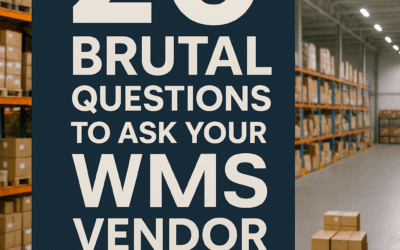“We just signed another 5-year contract with [legacy vendor name here].”
If you’ve heard this — or said it yourself — you’re not alone. But you’re likely stuck in a pattern that’s costing you efficiency, money, and agility.
Even in 2025, companies continue investing in outdated enterprise platforms like SAP HANA, Oracle NetSuite, and Salesforce CRM — or legacy WMS systems originally developed decades ago. These platforms were built by software developers, not warehouse operators, and they’ve become bloated, over-customized, and slow to evolve.
Meanwhile, modern SaaS solutions — developed by experts with 30+ years of direct experience in logistics and ERP — offer better speed, support, and return on investment.
So why do companies keep repeating the same costly mistake?
Let’s explore the psychological traps and procurement dysfunction that keep legacy vendors in business — and what you can do to break free.
1. Familiarity = Safety (Even When It’s a Trap)
“Better the devil you know…”
Legacy WMS platforms like Blue Yonder, Infor, or HighJump (now Körber) have been around for decades. They’re deeply embedded, often poorly documented, and painfully familiar. Users and IT staff have learned to tolerate the quirks — and fear starting over.
🧩 Truth: Familiarity is not value. It’s the illusion of control in a broken process.
2. Big Brand = Career Insurance
“No one gets fired for buying SAP.”
Executive decision-makers default to “safe brands” like SAP HANA, Oracle, or Salesforce, because those names look good on a board presentation. These platforms offer political cover — if the system fails, the buyer blames complexity, not their decision.
💡 Modern truth: Safe for your resume ≠ safe for your business.
3. Sunk Cost Fallacy: “We’ve Already Spent So Much”
“We can’t switch now — we’ve already invested too much.”
Companies spend years and millions customizing these systems. That investment creates emotional and financial inertia. Instead of switching, they keep paying — for maintenance, licensing, and outside consultants.
💣 Hard truth: Just because you’ve wasted money doesn’t mean you should waste more.
4. The Scalability Myth
“We need a system that grows with us.”
That’s the siren song of legacy platforms — sell you on future scalability, while delivering today’s pain. In reality, most companies use less than 25% of the features in these systems. The rest? Complexity for the sake of billable hours.
🆕 Modern WMS systems are built lean — fast to deploy, easy to train, and scalable by default.
5. Consultant Dependency & Lock-In
Most legacy systems come with an entire partner ecosystem that profits off your confusion. Complexity drives consulting revenue. You don’t own your software — you rent it and pay extra every time you want to use it properly.
⛓️ Today’s SaaS solutions are designed to eliminate that dependency, not monetize it.
6. Decisions Made by Committees, Not Operators
“We chose it after a 9-month RFP process.”
Procurement committees love paper checklists. Real users need working features. The problem? These two rarely align. WMS buying decisions are often driven by PowerPoint slides, not picking paths.
⚙️ Operational fit should be prioritized over legacy “enterprise grade” labels.
7. Old Code Built by Developers, Not Operators
Legacy WMS platforms were coded decades ago, by developers who had never worked a warehouse shift.
Here are the most common legacy WMS systems still being sold or upgraded in 2025:
Top 10 Legacy WMS Platforms Still in Use:
-
SAP Extended Warehouse Management (SAP EWM / SAP HANA)
-
Oracle WMS Cloud / NetSuite WMS
-
Blue Yonder (JDA)
-
Infor WMS (Baan/EXE heritage)
-
Radio Beacon / Accellos/HighJump / Körber
-
Manhattan Associates (legacy WMOS versions)
-
Tecsys WMS
-
Descartes WMS
-
Made4Net WMS (now part of WiseTech Global)
-
LogFire (acquired by Oracle, now sunset)
All were built for a different era — where on-premise deployment, expensive upgrades, and 18-month implementation timelines were the norm.
In contrast, modern systems like P4 Warehouse are built by experts with 30+ years of hands-on experience in global logistics, 3PL operations, and Tier 1 ERP/WMS integrations — not just code.
💡 The Shift: From Legacy to Logic
To stop buying the wrong software:
✅ Ask who built it — and why.
✅ Demand operational ROI — not just technical features.
✅ Map your business process, not their product roadmap.
✅ Look beyond the logo — and into the user experience.
✅ Run a pilot with real data — not a sales demo.
🚀 Conclusion: Build for the Floor, Not the Boardroom
Buying software should be a profit decision, not a political one.
The longer you stay locked into old systems, the more opportunity cost you pay in lost productivity, poor visibility, and expensive firefighting.
If your WMS or ERP still requires:
-
Dedicated servers
-
Year-long “integration roadmaps”
-
Separate mobile development licenses
-
Or manual EDI workarounds…
It’s not modern. It’s legacy wrapped in lipstick.
🟧 About P4 Software
P4 Software delivers modern cloud-native solutions for warehouse management (P4 Warehouse) and enterprise resource planning (P4 Books). Built by industry veterans, we serve thousands of users across the Americas and beyond.
👉 Learn more at https://p4.software
⚖️ Legal Disclaimer
All product names, logos, and brands are property of their respective owners.
All company, product, and service names used in this article are for identification purposes only.
Use of these names does not imply endorsement or affiliation.
Comparisons presented here are based on publicly available information, user feedback, and industry experience. P4 Software does not claim or guarantee feature parity with the systems mentioned.



